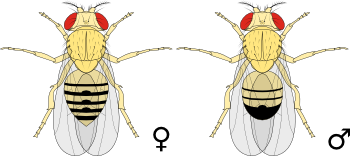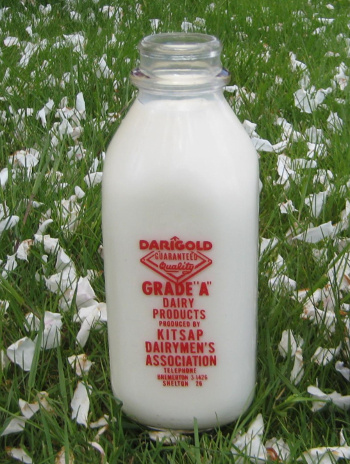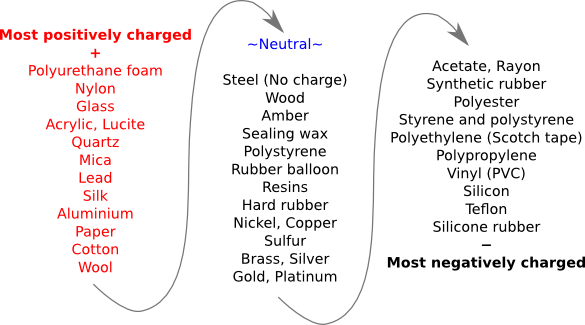Fruit Fly Culture
August 24, 2015
"Culture" is one of those words with multiple meanings. The word, "mole" means something different to a
chemist and a
gardener. One meaning of "culture" is used by
biologists to express the cultivation of
organisms for
research purposes. Thus, we have
cell culture,
tissue culture,
microbiological culture, and
viral culture. The word can apply, also, to raising the
common fruit fly (Drosophila melanogaster) for
genetics experiments.

Drosophila melanogaster, female (left) and male (right).
(Via Wikimedia Commons.)
The other meaning of
culture, the one that most people bring to mind upon hearing the word, is the way members of a particular group lead their lives. It's fun to imagine what the title of this article, "Fruit Fly Culture," would mean in that context. Just as our culture has its
gourmands, we can imagine a fruit fly food
blogger extolling the
pleasures of one type of
banana over another. I've always preferred
Chiquita to
Dole.
Fruit flies have been used in genetics experiments for a
century, long before the
chemical nature of genetics was discovered by
James Watson and
Francis Crick. A
colleague of mine once called
YIG (yttrium iron garnet, Y3Fe5O12) the "fruit fly of
magnetism," principally because it can be modified in many ways, and it has an
arrangement of its atoms and their magnetic directions that makes
analysis easy.
Early genetics experiments involved
irradiating fruit flies with
X-rays to
mutate their
offspring. They were ideally suited to this task, since they have a
generation time of only ten days, and the
females lay many
eggs per day. Of course, to do such experiments, you need a stock of fruit flies.
The 1989
film,
Field of Dreams, is noted for the memorable line, "If you build it, he will come." This is true, also for fruit flies, since any piece of
ripe fruit will be quickly
colonized by fruit flies.
Geneticists took advantage of this by placing banana mush in
glass milk bottles to attract some fruit flies, and then sealing them to keep the
population intact. In the early days of the field, glass milk bottles of a convenient
half-pint (~250
milliliter) size were common.

A one quart US milk bottle, circa 1956.
Elbridge Amos Stuart, a co-founder of the evaporated milk producer, Carnation, believed that cows pastured in a nice environment ("contented" cows) gave better milk. For many years, Carnation used the slogan, "Carnation Condensed Milk, the milk from contented cows."
(Portion of a photo by Joseph Tylczak, via Wikimedia Commons.)
Just as
species go
extinct, so do certain
products and
professions. Milk delivery men ("
milkmen") were still common in my
childhood, but that
profession, with its reusable glass bottles, starting into extinction in the 1960s with the rise of the
supermarket. At that point, milk appeared in non-reusable
waxed paper and
plastic containers.
At the start of the
1980s, there was a shortage of milk bottles for Drosophila culture. Geneticists scrambled to secure supply of their staple item, and they even tried to arrange for a
group purchase. This situation is much like a recent problem
mathematicians are having with
chalk.[2] As reported in
gizmodo, mathematicians prefer to use a traditional
blackboard for their
ruminations using a particular chalk that's been manufactured for 80 years by a
Japanese company, Hagoromo Bungu.
This
mathemagical chalk is less
dusty than others, and it's sturdier, but the company has been sold to a larger
office supply company, and the
formulation has changed. Although
whiteboards have replaced most blackboards, there are advantages to chalk. There's a clear indication when your writing medium is depleted, and
nasty chemicals are not required for erasure. Some mathematicians are reported to be hoarding their chalk, but there will be a
tipping point sometime in the future.[2]
Eventually, geneticists transitioned to more expensive, but available, items from
laboratory supply houses. Since much laboratory "
glassware" was transitioning to substitute
materials such as
polypropylene and
polystyrene,
polymer fruit fly culture bottles became common. As it turns out, this simple change of material might not be so simple after all.
Because of the
atomic nature of
matter, materials will develop an
electrical charge when they come in contact with other materials. I wrote about this
triboelectric effect in a
previous article (Triboelectric Generators, July 25, 2012). The tendency for charges to develop is governed by the
triboelectric series. While glass and polypropylene might seem to be equivalent as container materials, their tendency to donate or acquire
electrons is considerably different, as can be seen in the following figure.

The triboelectric series, drawn using Inkscape from Wikipedia data.)
Scientists and
engineers from the
University of Southampton (Southampton, UK),
Al Baha University (Al Baha, Saudi Arabia),
Hokkaido University (Sapporo, Japan), and the
Japan Science and Technology Agency (Kawaguchi, Saitama, Japan) have discovered that Drosophila avoid
electric fields, and their avoidance is a function of the field
strength.[3-4] Chronic exposure to electric fields was found to induce
neurochemical changes in their
brains and changes in
biogenic amine levels.[3]
The
root cause of this behavior appears to be
physical forces on the
wings arising from the charge. This was verified by observing how the wings of stationary flies could be manipulated by an electric field.
Experiments on excised wings showed that these forces could lift the wings, and the smaller wings of the
males were lifted at lower fields than the larger
female wings.[3] As
Philip Newland, a
professor of
neuroscience at the University of Southampton and lead
author of the study, explains,
"When a fly was placed underneath a negatively charged electrode, the static field forces caused elevation of the wings toward the electrode, as opposite charges were attracted... Static electric fields are all around us but for a small insect like a fruit fly it appears these fields' electrical charges are significant enough to have an effect on their wing movement and this means they will avoid them if possible."[4]
Such forces on their wings appears to agitate the flies, and this discomfort is shown in the changes to their brain chemistry by increased levels of
octopamine, the fruit fly version of
human noradrenaline. The increase in this chemical signals
stress and
aggression. There were also decreased levels of
dopamine, so the flies would be more responsive to external
stimuli.[4]
Since plastic containers can hold significant charge for long periods, such an effect might cloud the results of some fruit fly studies.[4] As Newland explains,
"Fruit flies are often used as model organisms to understand fundamental problems in biology... 75 per cent of the genes that cause disease in humans are shared by fruit flies, so by studying them we can learn a lot about basic mechanisms."[4]
This effect might be useful as a means of
pest control by blocking the ingress of
flying insects into
homes and
greenhouses. It may also have an
environmental consequence by modifying the behavior of
pollinators, such as
bees, near
power lines.[4] I wrote about power line electric fields in a
recent article (Ionized Air, July 9, 2015).
References:
- Field of Dreams, 1989, Phil Alden Robinson, Director, on the Internet Movie Database.
- Sarah Zhang, "Why Mathematicians Are Hoarding This Special Type of Japanese Chalk," Gizmodo, June 15, 2015.
- Philip L. Newland, Mesfer S. Al Ghamdi, Suleiman Sharkh, Hitoshi Aonuma, and Christopher W. Jackson, "Exposure to static electric fields leads to changes in biogenic amine levels in the brains of Drosophila," Royal Society Proceedings B, vol. 282, no. 1812 (July 29, 2015), DOI: 10.1098/rspb.2015.1198.
- Electric fields signal 'no flies zone,' University of Southampton Press Release, July 31, 2015.
Permanent Link to this article
Linked Keywords: Chemist; gardener; biologist; organism; research; cell culture; tissue culture; microbiological culture; viral culture; Drosophila melanogaster; common fruit fly; genetics; experiment; female; male; culture; gourmand; blog; blogger; pleasure; banana; Chiquita Brands International; Dole Food Company; century; Molecular Structure of Nucleic Acids: A Structure for Deoxyribose Nucleic Acid; chemical nature of genetics; James Watson; Francis Crick; colleague; YIG (yttrium iron garnet, Y3Fe5O12); magnetism; crystal structure; analysis; irradiation; X-rays; mutation; mutate; offspring; generation time; female; egg; film; Field of Dreams; ripe; fruit; colony; colonized; geneticist; glass; milk bottle; population; pint; milliliter; quart; United States; evaporated milk; Carnation; cow; pasture; environment; milk; slogan; Wikimedia Commons; species; extinction; extinct; product; profession; milkman; childhood; supermarket; waxed paper; plastic; food packaging container; 1980s; group purchase; mathematician; chalk; gizmodo; blackboard; rumination; Japanese; mathemagical; dust; office supply; formulation; whiteboard; toxic; nasty; chemical compound; tipping point; laboratory; glassware; material; polypropylene; polystyrene; polymer; atom; atomic nature; matter; electric charge; electrical charge; triboelectric effect; triboelectric series; electrons; Inkscape; Wikipedia data; scientist; engineer; University of Southampton (Southampton, UK); Al Baha University (Al Baha, Saudi Arabia); Hokkaido University (Sapporo, Japan); Japan Science and Technology Agency (Kawaguchi, Saitama, Japan); electric field; intensity; strength; neurochemical change; brain; biogenic amine; root cause; physical force; wing; experiment; Philip Newland; professor; neuroscience; author; negative charge; electrode; Coulomb's law; opposite charges attract; insect; octopamine; human; noradrenaline; stress; aggression; dopamine; stimulus; biology; gene; disease; pest control; Pterygota; flying insect; home; greenhouse; environment; pollinator; bee; power line; Field of Dreams, 1989, Phil Alden Robinson, Director.